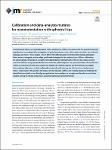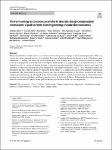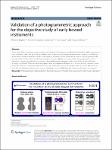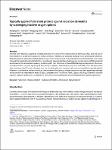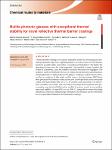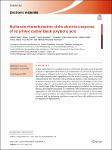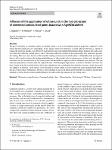Search
Author
- Osman, Ahmed I. (5)
- Daqing, Ma (3)
- Jorgensen, Ed (3)
- Li, Yan (3)
- next >
Subject
- kinh tế (26)
- Economics (12)
- programming (10)
- XRD (10)
- next >
Date issued
- 2020 - 2025 (2129)
- 2010 - 2019 (129)
- 2000 - 2009 (9)
- 1999 - 1999 (1)
Has File(s)
Search Results
Instrumented spherical nanoindentation with a continuous stiffness measurement has gained increased popularity in microphysical investigations of grain boundaries, twins, dislocation densities, ion-induced damage, and more. These studies rely on different methodologies for instrument and tip calibration. Here, we test, integrate, and re-adapt published strategies for tip and machine-stiffness calibration for spherical tips. We propose a routine for independently calibrating the effective tip radius and the machine stiffness using standard reference materials, which requires the parametrization of the effective radius as a function of load. We validate our proposed workflow against key benchmarks and apply the resulting calibrations to data collected in materials with varying ductili... |
Chemical substitution, which can be iso- or heterovalent, is the primary strategy to tailor material properties. There are various ways how a material can react to substitution. Isovalent substitution changes the density of states while heterovalent substitution, i.e. doping, can induce electronic compensation, ionic compensation, valence changes of cations or anions, or result in the segregation or neutralization of the dopant. While all these can, in principle, occur simultaneously, it is often desirable to select a certain mechanism in order to determine material properties. Being able to predict and control the individual compensation mechanism should therefore be a key target of materials science. This contribution outlines the perspective that this could be achieved by taking ... |
Metal soaps, the organic salts resulting from the interaction of fatty acids and metal cations, arouse interest in the scientific field because of their versatility in a great range of chemical applications as well as because of the mechanism of their formation during degradation processes. This article presents a review of the synthetic pathways used to produce metal soaps, their relevant physico-chemical properties, and how these reflect in their applications. Common industrial uses of metal soaps are reported, with a particular focus on those applications, such as cosmetics, paints, and coatings, that have an impact on the cultural heritage field. In addition, the occurrence of metal soaps in cultural heritage studies is presented, ranging from archaeological and ethnographic art... |
Some early violins have been reduced during their history to fit imposed morphological standards, while more recent ones have been built directly to these standards. We propose an objective photogrammetric approach to differentiate between a reduced and an unreduced instrument, whereby a three-dimensional mesh is studied geometrically by examining 2D slices. Our contribution is twofold. First, we validate the quality of the photogrammetric mesh through a comparison with reference images obtained by medical imaging, and conclude that a sub-millimetre accuracy is achieved. Then, we show how quantitative and qualitative features such as contour lines, channel of minima and a measure of asymmetry between the upper and lower surfaces of a violin can be automatically extracted from the va... |
Adverse skin reactions caused by ionizing radiation are collectively called radiation dermatitis (RD), and the use of nanomedicine is an attractive approach to this condition. Therefore, we designed and large-scale synthesized fullerenols that showed free radical scavenging ability in vitro. Next, we pretreated X-ray-exposed cells with fullerenols. The results showed that pretreatment with fullerenols significantly scavenged intracellular reactive oxygen species (ROS) produced and enhanced the antioxidant capacity, protecting skin cells from X-ray-induced DNA damage and apoptosis. Moreover, we induced RD in mice by applying 30 Gy of X-ray irradiation, followed by treatment with fullerenols. We found that after treatment, the RD scores dropped, and the histological results systematic... |
Thermal barrier coatings are essential materials systems for insulating and protecting substrates exposed to high temperatures. In such systems, the heat transfer has three possible paths: conduction, convection and irradiation. The higher the operating temperature, the more important it is to control or protect against the radiative component, since the radiative heat flux becomes non-negligible. The radiation can be controlled by the use of ceramic-based photonic nanostructures, namely photonic crystals and photonic glasses, creating so-called reflective thermal barrier coatings. In this work, mullite inverse photonic glasses (PhG) have been produced by thermally induced reaction on sol–gel-based silica structures coated with nanometric films of Al2O3 by atomic layer deposition. T... |
In this paper, the electrical response of a carbon black polylactic acid 3D printed polymer is characterised in detail by a combination of advanced experimental techniques at different scale lengths. The electrical properties as a function of the temperature become repeatable after the second heating cycle, exhibiting different trends as a function of the printing parameters. Joule heating and oven-heating techniques have been compared, showing the advantages of the Joule heating method to maintain electrical conductivity due to the lower thermal inertia. Small-Angle X-Ray Scattering has been employed to discern the underlying physics, showing the crucial role of crystallinity, filler dispersion and carbon black aggregates to form an effective segregated conductive network. |
Exosomes are known as nanovesicles that are naturally secreted, playing an essential role in stem-mediated cardioprotection. This study mainly focused on investigating if exosomes derived from miR-214 overexpressing mesenchymal stem cells (MSCs) show more valid cardioprotective ability in a rat model of acute myocardial infarction (AMI) and its potential mechanisms. |
The numerous new pigments that gradually became available to artists during the nineteenth-century Colour Revolution were received with contrasting attitudes. The initial enthusiasm for new chromatic possibilities was soon nuanced by concerns about the stability and performance of industrial materials. This study focuses on the work of John Ruskin, the famous art critic of Victorian England, whose artistic production was as impressive as his penmanship. Archival research into nineteenth-century literature is combined with material analyses with macro-XRF, XRD and FORS on a group of watercolours by Ruskin preserved at the Ashmolean Museum to determine his attitude towards pigment stability. |
The poor wettability of cemented carbides by molten metals as well as the different material properties compared to steel makes thermal joining process challenging. In this regard, innovative ultrasonic-assisted induction brazing is capable of joining the materials quickly, cost-effectively and without using environmentally hazardous fluxes. Instead, the oxide scales are broken up within the joining process due to ultrasonic-induced cavitation in the molten filler alloy and hence promote the wetting. However, since the use of ultrasound in brazing steel/cemented carbide joints is still insufficiently investigated, there is still a need to explore the fundamental influences of ultrasound on the brazing process. In this work, the effect of ultrasound on the microstructure of the braze... |

